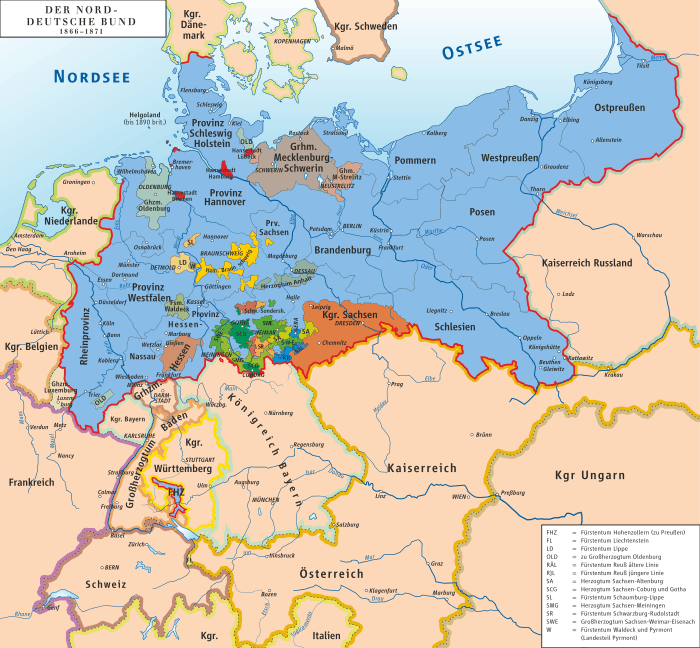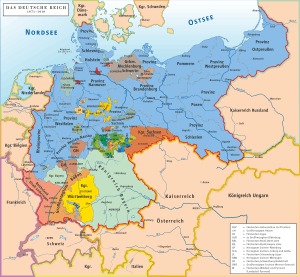The Grand Duchy of Mecklenburg-Strelitz consisted of two detached parts, Neustrelitz to the east of the Grand Duchy of Mecklenburg-Schwerin and the Principality of Ratzeburg on the west. The first was bounded by Schwerin, Pomerania and Brandenburg, the second by Schwerin, Lauenburg, and the territory of the Free City of Lübeck.
History
Mecklenburg-Strelitz adopted the constitution of the sister Duchy of Mecklenburg-Schwerin by an act of September 1755. In 1806 it was spared the infliction of a First French Empire occupation through the good offices of the King of Bavaria, Maximilian I Joseph; in 1808 Charles II, Grand Duke of Mecklenburg-Strelitz joined the Confederation of the Rhine, but withdrew in 1813 in favor of an alliance against Napoleon. He joined the German Confederation established after the Congress of Vienna to succeed the Holy Roman Empire in 1815 and assumed the title of grand duke.
In 1866 the grand duchy joined the North German Confederation and the Zollverein, and came under the influence of the Kingdom of Prussia, which in the Austro-Prussian War with the Empire of Austria had been aided by soldiers from Mecklenburg-Strelitz. Also in the Franco-Prussian War the Kingdom of Prussia received valuable assistance from Mecklenburg-Strelitz. In 1871 the grand duchy became a state of the German Empire. Mecklenburg-Strelitz returned one member to the Reichstag. However, the grand duke was still styled Prince of the Wends, and the internal government of the duchy remained unmodernized. There was now a renewal of agitation for a more democratic constitution, and the German Reichstag gave some countenance to this movement. In 1904 Adolphus Frederick V, a son of Grand Duke Frederick William and his wife Princess Augusta of Cambridge, daughter of Prince Adolphus, became grand duke of Mecklenburg-Strelitz. In 1907, the grand duke promised a constitution to the duchy's subjects, but this was met with opposition from the nobility. The duchy had always been a government of feudal character, the grand dukes exercising absolute power through their ministers, with an antiquated type of diet representing social classes, It met for a short session each year, and at other times was represented by a committee consisting of the proprietors of knights' estates (Rittergüter), known as the Ritterschaft, and of the Landschaft, which was composed of burgomasters of selected towns. Mecklenburg-Strelitz returned one member to the Reichstag. The grand duke was still styled Prince of the Wends.
Aftermath
The Mecklenburg-Strelitz dynasty ended just prior to the loss of the monarchy in developments associated with World War I. At that time, there existed only two surviving recognized male dynasts of Strelitz, the young Grand Duke Adolphus Frederick VI, and his cousin Charles Michael, who was in Russian service, being a son of Grand Duchess Catherine Mikhailovna. In 1914, before the proclamation of war between Germany and Russia, Duke Charles Michael renounced his Mecklenburgish citizenship. On 23 February 1918, Grand Duke Adolf Frederick VI committed suicide, leaving his cousin Charles Michael as heir to the Strelitz throne. Being in Russia, however, Charles Michael did not assume the throne, and in 1918 he wrote to Grand Duke Frederick Francis IV of Mecklenburg-Schwerin, who was acting as regent in Strelitz, stating that he wished to renounce his rights of succession to Strelitz, though the letter was only received by Frederick Francis in 1919 after the end of the German monarchies, so the issue of succession could not be resolved at the time.
The House of Mecklenburg-Strelitz survives to this day, descending from Duke George, the morganatic son of Duke George Alexander with Countess Natalia Carlow and nephew of Duke Charles Michael, who adopted him in 1928. George subsequently assumed the title "Duke of Mecklenburg" (Serene Highness) which was acknowledged by Grand Duke Frederick Francis IV of Mecklenburg-Schwerin. He was later given the style of "Highness" by the House of Mecklenburg-Schwerin. George's grandson Borwin is the present head of the House of Mecklenburg-Strelitz.
The county of Mecklenburg in the U.S. state of North Carolina, which includes the city of Charlotte, is named after the duchy. The City of Charlotte, known as "The Queen City" was named for Queen Charlotte, wife of King George, III of England. Queen Charlotte was Princess Charlotte of Mecklenburg-Strelitz, born on 19 May 1744. She was the youngest daughter of Duke Charles Louis Frederick of Mecklenburg-Strelitz, Prince of Mirow and his wife Princess Elizabeth Albertine of Saxe-Hildburghausen.
References
 This article incorporates text from a publication now in the public domain: Chisholm, Hugh, ed. (1911). "Mecklenburg". Encyclopædia Britannica 17 (11th ed.). Cambridge University Press. pp. 1018–20.
This article incorporates text from a publication now in the public domain: Chisholm, Hugh, ed. (1911). "Mecklenburg". Encyclopædia Britannica 17 (11th ed.). Cambridge University Press. pp. 1018–20.
External links
|
|---|
| | Empires | | |
|---|
| | Kingdoms | |
|---|
| | Electorates | |
|---|
| | Grand Duchies | |
|---|
| | Duchies | |
|---|
| | Principalities | |
|---|
| | City-states | |
|---|
| | Unrecognized | |
|---|
|
- 1 w/o areas listed under other territories
- 2 Merged with Anhalt from 1863
- 3 until 1847
- 4 from 1839
- 5 from 1826
- 6 until 1826
- 7 until 1850
- 8 1849–60
- 9 as of 1849
- 10 until 1837
- 11 until 1829
- 12 until 1848/57
- 13 until 1848
- 14 as of 1848
- 15 as of 1829
- 16 as of 1864
|
|
|
|---|
| | Kingdoms | | |
|---|
| | Grand Duchies | |
|---|
| | Duchies | |
|---|
| | Principalities | |
|---|
| | City-states | |
|---|
|
|
|---|
| | Kingdoms | | |
|---|
| | Grand Duchies | |
|---|
| | Duchies | |
|---|
| | Principalities | |
|---|
| | City-States | |
|---|
| | Imperial state | |
|---|
| | Other territories | |
|---|
|
.svg.png)
![]() This article incorporates text from a publication now in the public domain: Chisholm, Hugh, ed. (1911). "Mecklenburg". Encyclopædia Britannica 17 (11th ed.). Cambridge University Press. pp. 1018–20.
This article incorporates text from a publication now in the public domain: Chisholm, Hugh, ed. (1911). "Mecklenburg". Encyclopædia Britannica 17 (11th ed.). Cambridge University Press. pp. 1018–20.


